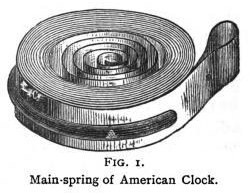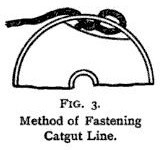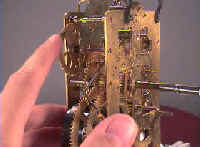The Clock Jobber's Handybook
By Paul N. Hasluck
Brought to you by:
Tick Tock Productions
The
CLOCK JOBBER'S HANDYBOOK.
CHAPTER 1. Various Clocks Described.
CLOCKS
are represented by various types, each possessing distinctive
peculiarities. England, France, Germany and America, each contribute to
furnish the large number of clocks distributed through the whole world. An
account of the development of time measurers, from the days of sun-dials
to the present time, will be found in THE WATCH JOBBER'S HANDYBOOK, which
forms a companion volume to, and should be perused by all readers of, this
Handybook.
The manufacture of clocks in England at the present time is principally
confined to spring dials, high class regulators, skeleton, bracket, chime,
electric and turret clocks. The trade in ordinary house clocks has long
since become very small, the cheaper productions of America and Germany,
or the more artistic and less cumbersome designs from France, having
almost entirely supplied our wants. At the same time there will be found
in English homes, especially in rural districts, a very large number of
old English house clocks, testifying to the skill and ability of our
forefathers. These clocks are of two kinds : the " thirty hour,"
which requires winding daily, and the
" eight day," which requires winding once a week. They are
generally characterised by the solidity of both their mechanism and case,
and are certainly the most durable and best timekeepers for general use ;
the only objection which can be fairly raised against them is their cost.
As to the shape of the case, against which some make objection, there is
many a piece of furniture still retained, much less ornamental, and
certainly not so useful as the old English long-case clock. Respecting
their durability, some of these old clocks have faithfully discharged
their duty for upwards of a hundred years without being worn anything like
so much as most modern clocks are in the course of seven years' use. They
were made originally in most towns of importance, each maker cutting his
own wheels and finishing the movement throughout, the case often being
supplied by the local cabinetmaker. The same treatment in cleaning,
repairing and adjusting is not applicable to all clocks, and some
particulars of the distinct varieties in common use will be useful so that
the beginner may distinguish the nationality and some other important
details before commencing operations. Arranging clocks and timepieces in
alphabetical order for convenience of reference we have :
American Clocks, which are distinct from all others; they are made in
large quantities by machinery, on the most economical principles. Being
very cheap, tolerably good-looking, and fair time-keepers, American clocks
are exceedingly popular, and generally at least one specimen has a place
in every household where clocks are to be found at all. Some few have
weights, which are arranged to fall the entire height of the case, but
nearly all have springs. Small timepieces for the mantel, and large dials
for the wall, are made, and also every other variety that is saleable. The
small original cost of these American productions, their really
serviceable timekeeping qualities, and their good looks combine to make
them favourites. The main-springs of these clocks are peculiar, as they
are not fitted into a barrel. The inner end, or eye, is hooked to the
arbor of the wind-up square in the usual way. The outer end is formed into
a loop, which is slipped upon one of the frame pillars. The accompanying
illustration, Fig. i, shows the main-spring as bought from the material
shops. The piece of iron wire, which confines it, is taken off when the
mainspring is put in place, a few turns of the wind-up square will allow
this iron wire to fall off. It is a good plan to use similar irons to keep
the main-spring within limits when taking these clocks apart. When
examining American clocks that fail to go satisfactorily, try the pinions
to see if they are tight on the arbors, for they are often loose.

An
effectual way to secure them is with a little soft solder, taking great
care afterwards to thoroughly clean off all the soldering fluid with chalk
and water, and finally oil the arbor slightly all over. When the pendulum
wabbles it is owing to the suspension spring being crippled, that is,
twisted, bent or partially broken, or it may be loose in the stud, or
there may be want of proper freedom for the pendulum wire in the crutch.
To adjust the striking works of an American clock is not a difficult job
to anyone who has some mechanical knowledge, though the operation is not
easy to describe on paper in language which may be easily understood by
those unversed in the technicalities of horology. First take the hands off
the
The cases of American clocks are
generally of the cheapest possible construction. They are made in a few
patterns of veneered moulding, in the cheapest manner possible. The wheels
and frames are stamped to shape; the pinions used are those known as
"lanterns," and are mostly all machine
made. American clocks are mostly of the useful class going thirty
hours or eight days timepieces, clocks, dials, and calendar clocks.
There is also a variety called Anglo-American, the movements of which are
made in America, and the wood cases, which are more solid than the
ordinary American cases, are made in England. Bracket Clocks, so far as
the mechanism is concerned, are like spring dials. The case is adapted to
stand on a bracket, instead of to hang against the wall; and it is in this
peculiarity that the difference lies. Bracket clocks were much in favour
with past generations, and some may now be found fitted with the verge
escapement.
Chime Clocks, properly, are those which, in addition to striking the hour,
play changes on a certain number of bells every quarter of an hour. Those
clocks which play a tune every three or four hours are not, strictly
speaking, chime, but musical clocks. Chime clocks are usually made either
as
bracket, skeleton or long case clocks. They have an extra train of wheels,
working independently of the going and striking trains, which is also
wound separately. These clocks are also known as quarter clocks. The
number of bells on which the chime is played may be two or more. When only
two bells are used the chime is termed a "ding-dong." Chime,
musical and quarter clocks call for no especial remarks, beyond that it is
advisable to well understand the action of the "letting-off"
work, and the " run " allowed before taking to pieces. The
arrangements differ so much that scarcely anyone is likely to have to deal
with two actions precisely alike; but they seldom offer any great
difficulty when ordinary care is taken. It is wise in some cases to keep
the striking and chime parts separate while cleaning. Most of these clocks
present features of construction favourable for improvement by reducing
the friction. When this can be safely done, it is well to reduce friction
at any point where it is noticed as being excessive, for, though the
weights or springs are often very powerful, there is generally no power to
spare. Electric Clocks are of two kinds one, those in which the
pendulum is kept in motion by the combined magnetism of permanent and
electro-magnets, the poles of the latter being changed at every beat by
the action of the pendulum.
Another kind, driven by a weight in the usual manner, which would more
properly be called controlled clocks, as the only work that electricity
performs is to make the pendulum beat in unison with another belonging to
a standard clock. English Dials are the ordinary English office clocks,
which hang against the wall, and may be seen at most railway stations, and
in shops and offices. This is the type most largely used of all English
clocks, and close imitations of it are imported from America and Germany.
The diameter of the dial is generally named to specify the size of the
clock,
and 9 in., 12in.,15in., &c., "dials," are spoken of. When
the cases are circular, forming merely a rim to the dial, with a box to
cover the movement, the clocks are called "round dials." In
order to accommodate longer pendulums, a drop is added to the case, and
then it is called a "trunk," or "
drop dial." The pendulums of these clocks range from about seven
inches to twenty inches long, and the train is, of course, calculated
according to this length. The English spring dial has a fusee on which the
gut line or chain is wound from the barrel. Directions for replacing a
broken gut are given on page 10. The chain is repaired by first removing
the broken piece of link from one end with a penknife, using it to slice
the links apart; then the pair of links, as well as the broken piece, are
removed from the other piece of chain, by the same means. This breakage is
assumed to have
occurred across a single link, as is invariably the case. On parting the
links with the knife, the rivets will become loose and fall out, and the
chain can be put in position with the holes in the links one over the
other. A piece of steel wire filed up slightly tapering is put through,
and cut off close on
both sides, then riveted and made level with the side of the chain by the
aid of Arkansas stone.
In Spring Dials, and also in Skeleton and Bracket Clocks, the motive power
is produced by the uncoiling of a spring. Several parts are introduced
which are not found in weight clocks these comprise the barrel, to
contain spring, fusee, and stopwork. The cover of the barrel ought always
to be removed when cleaning the clock, to ascertain the condition of the
main-spring. If this is found to be dirty, it should be carefully removed
with a pair of pliers, and cleaned with a little turpentine on a piece of
rag. It may be replaced by winding it round its own arbor, which should be
screwed in the
vice by the squared end. Take hold of the end of the spring with a pair of
strong pliers, and wind it as tight as possible; then slip the barrel over
it and carefully let go the spring, holding the barrel tight with the left
hand until the spring has hooked. To try that it has hooked securely,
before replacing
it in the clock, put on the cover, clamp the end of the arbor in the vice,
and turn round the barrel until the spring is felt to be quite up. A new
spring can be put in in the same manner. Always oil the main-spring after
it has been put in the barrel. When a new barrel-hook is required, select
a piece of good steel, and file up a square pivot with a nicely-fitting
shoulder, and fit in the hole in the barrel; then shape the hook, and
rivet in its place. Clock movements which have fusees, and also those
driven by weights, have all the power annulled in the process of winding.
This stops the onward progress of the train, and, in some cases, even
causes a backward motion. To obviate this, maintaining power is arranged.
The fusee is liable to derangement of the clickwork, and when a chain is
used, breakage of the chain hook-pin. In addition to the chain, there are
two kinds of line used to connect the fusee with the barrel the catgut
and the metallic. Metallic lines are considered to wear better, look
better, and

the loop formed by the line passing through the first and second holes, as shown in Fig. 3.
Learn clock repair with these DVD courses! Course manuals are included.
Watch, study and learn antique clock repair through DVD course instruction using actual live repairs!!
Clock Repair 1 & 2 Advanced Clock Repair PRO advanced clock repair
Clockmaker Watchmaker Lathe Basics Clockmaker Watchmaker Lathe Projects Clock Case Repair & Restoration Wooden Works Movement Repair
© Copyright 2001-2009 by Tick Tock Productions © Copyright 2001-2009 by John Tope All rights reserved.
Back to clock information page.
Hasluck, Paul N. The Clock Jobbers Handybook. London: Crosby Lockwood and Son, 1889.
This and the following pages are excerpts from the book.
